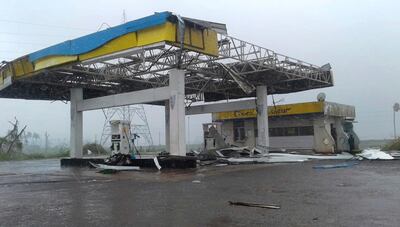Normally bustling Kolkata was eerily quiet late Friday as one of the biggest cyclones to hit India in years bore down on the major city after leaving a trail of deadly destruction in its wake.
Cyclone Fani - "Snake" in Bengali - slammed into the eastern state of Odisha earlier in the day, reportedly killing at least eight people and one in Bangladesh, where it was headed after Kolkata, officials said.
Cyclone Fani battered the city with winds of up to 205 kilometres an hour on Friday, after days of building up power in the northern reaches of the Bay of Bengal.
The storm hit the coast of Odisha state at around 8am near Hindu holy town of Puri, a major tourist destination that attracts millions of visitors every year. Media reports said hundreds of trees were uprooted at the nearby Chilika Lake just south of Puri in the first violent winds.
"The eye of the cyclone has moved over the land," said KJ Ramesh, director general of the India Meteorological Department. "Weakening of the intensity of the system is seen as per quick assessment through Doppler radars."
The monster weather system threatened to bring a dangerous storm surge that could flood low-lying areas, prompting authorities in Odisha to move more than a million people to about 3,000 shelters set up in schools and government buildings. Hundreds of disaster management personnel were deployed in the state, and doctors and other medical staff have been told not to take leave until May 15. Schools and colleges have been shut.
It is a "very, very scary feeling," said Tanmay Das, a 40-year-old Bhubaneswar resident, who described "the sound of wind as if it will blow you away."

Fani is expected to barrel north-east into West Bengal state and towards Bangladesh, on a trajectory that will take it over the homes of 100 million people.
Eight people have been killed, the Press Trust of India (PTI) reported, including a teenage boy, a woman hit by concrete debris and an elderly woman who suffered a heart attack in one of several thousand shelters packed with families.
Odisha disaster management official Prabhat Mahapatra said there were not yet any confirmed casualty figures.
"Around 160 people were injured in Puri alone. Our relief work is ongoing," he told AFP.
Meteorologists have warned of the "total destruction" of thatched houses, the uprooting of power and communication poles, the "flooding of escape routes" and damage to crops in some areas.
More than 200 trains have been cancelled along coastal routes, according to Indian Railways. Three special trains were running however from Puri to evacuate pilgrims and tourists.
Flights have been cancelled in and out of Odisha's capital Bhubaneswar and Kolkata in West Bengal until at least Saturday.
Ports have been closed but the Indian Navy has sent six warships to the region while India's biggest oil and gas producer ONGC evacuated almost 500 workers from offshore rigs.
Measures were also being taken to protect the eight-and-a-half-century old Jagannath temple in the city.
“We have adequate food material and have tried to do our best to deal with the situation,” said Bishnupada Sethi, special relief commissioner with the Odisha government. “No damage and loss of lives reported so far.”
Odisha, home to aluminium units, power plants, coal mines and the only coastal oil refinery in eastern India, is battered by cyclonic storms every year. The state was hit by a super cyclone in 1999 with wind speeds that were estimated to have reached a maximum 270 kph leaving almost 10,000 people dead.
In Bangladesh, disaster management chief Mohammad Hashim said that more than 4,000 cyclone shelters have been opened in 19 coastal districts.
The country's weather bureau has told deep-sea fishing vessels to stay near the coast, while inland water transport activities were suspended.
India's east coast is vulnerable to destructive storms.
In 2017 Cyclone Ockhi left nearly 250 people dead and more than 600 missing in Tamil Nadu and Kerala.
The 1999 storm wreaked $4.5 billion worth of damage, as well as taking 10,000 lives.
Watch: Cyclone Fani damages student hostel in Bhubaneswar
Weather affected far and wide
Cyclone Fani's impact was felt in the west in Mumbai and Rajasthan and as far north as Mount Everest.
Dust storms were forecast in the desert state of Rajasthan bordering Pakistan, heat waves in the coastal state of Maharashtra on the Arabian Sea, heavy rain in the northeastern states bordering China and snowfall in the Himalayas.
More than 2,300 kilometers away on Mount Everest, some mountaineers and Sherpa guides were descending to lower camps as weather worsened at higher elevations. The government issued a warning that heavy snowfall was expected in the higher mountain areas with rain and storms lower down, and asked trekking agencies to take tourists to safety.
Hundreds of climbers, their guides, cooks and porters huddled at the Everest base camp, according to Pemba Sherpa of Xtreme Climbers Trek, who said weather and visibility was poor. May is the best month to climb the 8,850-metre Everest when Nepal experiences a few windows of good weather to scale the peak.
"It is still the beginning of the month, so there is no reason for climbers to worry" that weather from the cyclone will cost them their chance to reach the summit, the Sherpa said.











